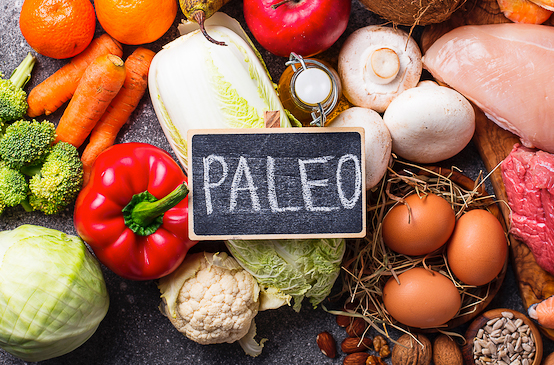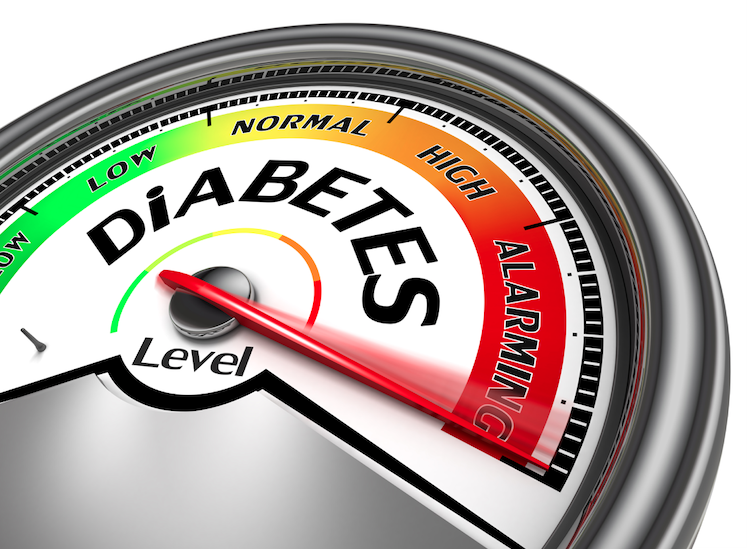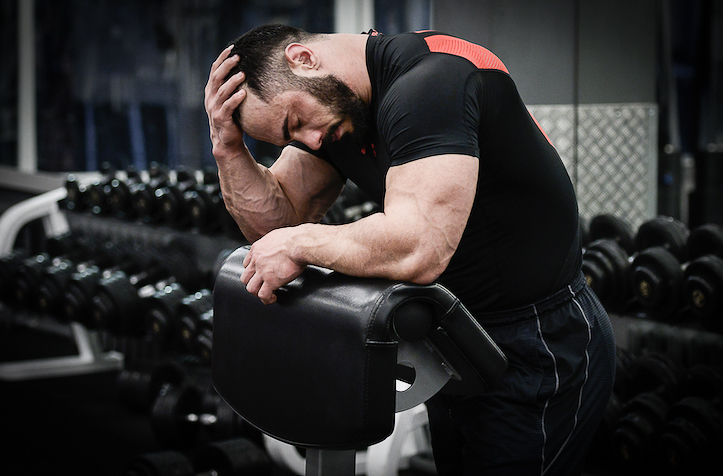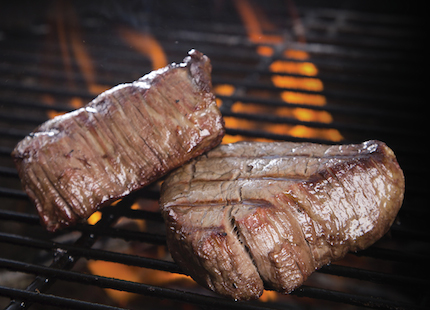The Paleo Diet - Fad or Not

Call it the “Paleo diet” (short for Paleolithic, like the era), the “Stone Age diet,” or the “Caveman diet”—a rose by any other name will still get you jacked.
It’s been lauded, criticized, chewed up, spit out, praised, and put down, yet here we are, still talking about it. Why the fascination with this way of eating? Why the intrigue behind this lifestyle? Why is this one dietary trend that we just can’t seem to shake?
History of the Paleo Diet
 Obviously the history of the Paleo diet dates back further than a lot of other “fad” diets, as it literally started as early as the Paleolithic/caveman/Pleistocene time period. This era has been documented to be about 2 to 2.6 million years old, and is characterized by use and development of stone tools, as well as tools made from wood and bone. At the time, humans subsisted by gathering plants and hunting fish and wild animals. Their diets consisted mostly of leafy vegetables, fruit, nuts and insects, meat, fish, and shellfish. Obviously, how much meat and fish they ate depended on the region the hunters lived in and how available (or scarce) the food was, so there would be times when the diet was more plant based, and others when it was more meat based. The hunters never let anything go to waste, as they didn’t know when or where their next meal would come from, and thus animal organ meats, including the livers, kidneys, and brains were a huge part of their diet as well. Tasty. Primitive. Easy. Low-carb. That brings us to the current incarnation of the Paleo diet, and how it’s practiced in the twenty-first century.
Obviously the history of the Paleo diet dates back further than a lot of other “fad” diets, as it literally started as early as the Paleolithic/caveman/Pleistocene time period. This era has been documented to be about 2 to 2.6 million years old, and is characterized by use and development of stone tools, as well as tools made from wood and bone. At the time, humans subsisted by gathering plants and hunting fish and wild animals. Their diets consisted mostly of leafy vegetables, fruit, nuts and insects, meat, fish, and shellfish. Obviously, how much meat and fish they ate depended on the region the hunters lived in and how available (or scarce) the food was, so there would be times when the diet was more plant based, and others when it was more meat based. The hunters never let anything go to waste, as they didn’t know when or where their next meal would come from, and thus animal organ meats, including the livers, kidneys, and brains were a huge part of their diet as well. Tasty. Primitive. Easy. Low-carb. That brings us to the current incarnation of the Paleo diet, and how it’s practiced in the twenty-first century.
Paleo: The Rules
To make it easy, instead of writing out a comprehensive list of can and cannot foods, here is a list of cans. If it’s not on this list, don’t eat it:
- Meat: Grass-fed rather than grain-fed.
- Fowl: Chicken, duck, turkey.
- Fish: Wild instead of farmed
- Eggs
- Vegetables
- Oils: Olive oil, coconut oil, avocado oil
- Fruits
- Nuts
- Tubers: Sweet potatoes and yams
Essentially, you’re not eating grains, dairy, starches/legumes, alcohol, or anything processed or refined. If you couldn’t hunt it or gather it 10,000 years ago, then don’t eat it now!
Paleo: The Good
 What the diet preaches is simple: They didn’t have diseases such as obesity, diabetes, and heart disease in the time of our caveman ancestors, so to eradicate said diseases and ward off the ill effects of the modern diet, we must return to their pre-civilization, humble, natural diet. One of the biggest pro-Paleo arguments is that our bodies still haven’t completely adapted to the new food-processing practices of modern civilization—that our bodies respond better to a lesser amount of refined and processed foods in the diet.1
What the diet preaches is simple: They didn’t have diseases such as obesity, diabetes, and heart disease in the time of our caveman ancestors, so to eradicate said diseases and ward off the ill effects of the modern diet, we must return to their pre-civilization, humble, natural diet. One of the biggest pro-Paleo arguments is that our bodies still haven’t completely adapted to the new food-processing practices of modern civilization—that our bodies respond better to a lesser amount of refined and processed foods in the diet.1
From a different health perspective, the Paleo diet has been studied by researchers and medical practitioners alike, because it’s been found to be advantageous to patients with diabetes and cardiovascular risk factors.1 In 2007, a study was done on 29 people with ischemic heart disease and either type 2 diabetes or glucose intolerance. The study was done to compare the Paleo diet to the Mediterranean diet (which is higher in whole-grains, low-fat dairy products, and margarine). The results showed a significantly greater improvement in glucose tolerance after 12 weeks with the Paleo group.2 In another study done on sedentary individuals in 2009, compared with their usual, “Westernized” diet, subjects who were put on a Paleo diet saw improvements in blood pressure and glucose tolerance, a decrease in insulin secretion, an increase in insulin sensitivity, and improvements in lipid profiles; those results were from only 10 days on the new regimen!
Paleo: The Bad and Ugly
 An article in the AmericanScience blog summarizes it succinctly and neatly, stating, “An important point about not only this fad diet, but indeed every fad diet: they all claim to be grounded in science. What is unique and special about the Paleo diet is that it draws on an unusual branch of science, namely evolutionary theory.”4 This diet isn’t rooted in the same science as all the others, which is what makes some people skeptical, and some people intrigued. Though the diet itself is ancient, its recent emergence into the modern world means it hasn’t been studied/researched as much from a health/physiological standpoint.
An article in the AmericanScience blog summarizes it succinctly and neatly, stating, “An important point about not only this fad diet, but indeed every fad diet: they all claim to be grounded in science. What is unique and special about the Paleo diet is that it draws on an unusual branch of science, namely evolutionary theory.”4 This diet isn’t rooted in the same science as all the others, which is what makes some people skeptical, and some people intrigued. Though the diet itself is ancient, its recent emergence into the modern world means it hasn’t been studied/researched as much from a health/physiological standpoint.
In addition, not all the Paleo diet suggestions are practical or safe—e.g., the consumption of raw milk. There are physiological dangers (because of harmful bacteria such as salmonella) to consuming milk that hasn’t been pasteurized. That’s why we invented the process in the first place!5 Proponents of the diet also encourage its practitioners to avoid nutrient-rich dairy, grains, and cereals, all of which can add micronutrient value to one’s diet. These are entire food groups being eliminated! There are as many studies showing foods such as yams and sweet potatoes are good for your insulin levels, as there are studies showing the negative effects.
Paleo: The Conclusion
 The conclusion is … there is no conclusion. Which way of eating you choose to follow is up to you. We at MUSCLE INSIDER are just here to report the facts and the research; you have to take into account your lifestyle, convenience, budget, palette, etc. So if this diet interests you, give it a legitimate shot. If it’s not for you, then no harm, no foul!
The conclusion is … there is no conclusion. Which way of eating you choose to follow is up to you. We at MUSCLE INSIDER are just here to report the facts and the research; you have to take into account your lifestyle, convenience, budget, palette, etc. So if this diet interests you, give it a legitimate shot. If it’s not for you, then no harm, no foul!
Paleo Recipes
Best Banana Pancakes

Ingredients:
- 2 bananas
- 2 eggs
- 1 Tbsp coconut flour
- 1–2 Tbsp almond butter
- Fresh or frozen blueberries
- ¼ cup nuts of choice (walnuts, macadamia, almonds are good), chopped
- 1 tsp coconut oil
- Dash of sea salt (optional)
Preparation:
- Mash bananas in a bowl.
- Add the eggs, coconut flour, almond butter, blueberries, nuts, and salt, and whisk until well blended.
- Heat a large non-stick skillet over medium heat along with a small pat of coconut oil.
- Pour small discs of batter onto the hot pan (around 3"–4" around). They’ll be easier to flip if you keep them from the edges of the pan.
- Flip when batter loses its “tackiness” around the edges.
- Cook other side slowly over medium heat until fully cooked.
- Reapply oil to the pan after each round of pancakes.
(recipe from paleoplan.com)
Almost 5 Ingredients Pizza Spaghetti Pie

Ingredients:
- 1 large spaghetti squash (about 600 g)
- 1 lb. Italian sausage
- ½ yellow onion, diced
- 1 cup pizza sauce (no sugar added)
- 1 tsp dried basil
- Salt and pepper, to taste
- 3 eggs, whisked
- (optional: add anything you like with pizza: veggies, basil, even cheese if you do primal)
Preparation:
- Preheat oven to 400°F.
- Cut spaghetti squash in half lengthwise. Place spaghetti squash cut side down on a baking sheet and bake for 20–25 minutes or until the skin of the squash gives when you press on it. Then reduce oven heat to 350°F.
- Once squash is done cooking, remove threads and place in an 8"×8" greased baking dish.
- Place a large pan over medium heat. Add Italian sausage and onion. Cook until pink no longer remains in the sausage and it is broken up into pieces.
- Add pizza sauce, dried basil and salt and pepper to the pan and mix well.
- Add sausage mixture to the 8"×8" dish and mix well with spaghetti squash threads. Lastly, add whisked eggs to the baking dish and mix everything together until you can no longer see the eggs.
- Place in oven and bake for 1 hour or until the top of the mixture forms a slight crust that doesn’t give when you press on it in the middle of the dish.
- Let rest for 5 minutes before serving.
(recipe courtesy of paleomg.com)
Chocolate Hazelnut Cups

Ingredients:
- Makes about 16–18 cups.
- 2 10-oz. bags of chopped hazelnuts (or almonds or any nut)
- 1 10-oz. bag of dark chocolate chips
- 2 Tbsp of coconut oil—one for the chocolate and one for the nuts
- Peanut butter cup candy mold
Preparation:
- Melt the chocolate over low heat, stirring in a tablespoon of coconut oil once the chips are melted.
- While your chocolate is melting, add the hazelnuts to a food processor and blend. That’s seriously it. It takes a few minutes, but you’ll have hazelnut butter before you know it. Throw in a tablespoon of coconut oil for good measure.
- Spoon some melted chocolate into the bottoms of your candy molds. Add a bit of hazelnut butter. Top it with another spoonful of chocolate.
- Stick them in the freezer until they've hardened and pop them out.
- Store them in the refrigerator.
(recipe courtesy of cavegirlinthecity.com)
References:
- Klonoff DC. The beneficial effects of a Paleolithic diet on type 2 diabetes and other risk factors for cardiovascular disease. J Diabetes Sci Technol. 2009;3.6:1229-232.
- Lindeberg S, Jonsson T, Granfeldt Y, et al. A Palaeolithic diet improves glucose tolerance more than a Mediterranean-like diet in individuals with ischaemic heart disease. Diabetologia. 2007;50(9):1795-807.
- Frassetto LA, Schloetter M, Mietus-Synder M, Morris RC, Jr., Sebastian A. Metabolic and physiologic improvements from consuming a paleolithic, hunter-gatherer type diet. Eur J Clin Nutr. 2009;63(8):947–955.
- Rieppel L. The curious history of the paleo-diet, and its relationship to science & modernity. AmericanScience: A Team Blog. Available at: http://americanscience.blogspot.ca/2013/05/the-curious-history-of-paleo-diet-and.html. Accessed June 3, 2014.
- Cunningham E. Are diets from the paleolithic time relevant today? J Acad Nutr Diet. 2012 Aug;112(8):1296.

